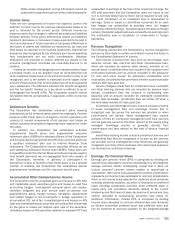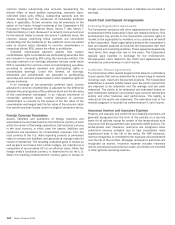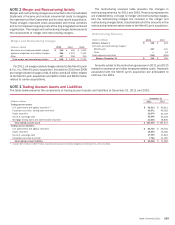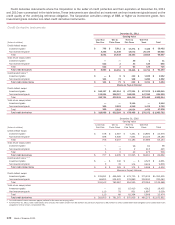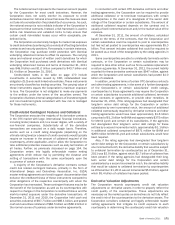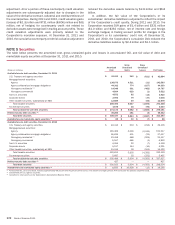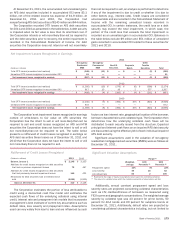Bank of America 2011 Annual Report Download - page 170
Download and view the complete annual report
Please find page 170 of the 2011 Bank of America annual report below. You can navigate through the pages in the report by either clicking on the pages listed below, or by using the keyword search tool below to find specific information within the annual report.
168 Bank of America 2011
Derivatives Accounted for as Economic Hedges
Derivatives accounted for as economic hedges, because either they did not qualify for or were not designated as accounting hedges,
are used by the Corporation to reduce certain risk exposures. The table below presents gains (losses) on these derivatives for 2011,
2010 and 2009. These gains (losses) are largely offset by the income or expense that is recorded on the economically hedged item.
Economic Hedges
(Dollars in millions)
Price risk on mortgage banking production income (1, 2)
Interest rate risk on mortgage banking servicing income (1)
Credit risk on loans (3)
Interest rate and foreign currency risk on long-term debt and other foreign exchange transactions (4)
Other (5)
Total
2011
$ 2,852
3,612
30
(48)
(329)
$ 6,117
2010
$ 9,109
3,878
(121)
(2,080)
(109)
$ 10,677
2009
$ 8,898
(4,264)
(515)
1,572
16
$ 5,707
(1) Gains (losses) on these derivatives are recorded in mortgage banking income.
(2) Includes gains on interest rate lock commitments related to the origination of mortgage loans that are held-for-sale, which are considered derivative instruments, of $3.8 billion, $8.7 billion and $8.4
billion for 2011, 2010 and 2009, respectively.
(3) Gains (losses) on these derivatives are recorded in other income (loss).
(4) The majority of the balance is related to the revaluation of economic hedges on foreign currency-denominated debt which is recorded in other income (loss).
(5) Gains (losses) on these derivatives are recorded in other income (loss), and personnel expense for hedges of certain RSUs, for 2011 and 2010.
Sales and Trading Revenue
The Corporation enters into trading derivatives to facilitate client
transactions, for principal trading purposes, and to manage risk
exposures arising from trading account assets and liabilities. It is
the Corporation’s policy to include these derivative instruments in
its trading activities which include derivatives and non-derivative
cash instruments. The resulting risk from these derivatives is
managed on a portfolio basis as part of the Corporation’s Global
Banking & Markets (GBAM) business segment. The related sales
and trading revenue generated within GBAM is recorded in various
income statement line items including trading account profits and
net interest income as well as other revenue categories. However,
the majority of income related to derivative instruments is recorded
in trading account profits.
Sales and trading revenue includes changes in the fair value
and realized gains and losses on the sales of trading and other
assets, net interest income, and fees primarily from commissions
on equity securities. Revenue is generated by the difference in the
client price for an instrument and the price at which the trading
desk can execute the trade in the dealer market. For equity
securities, commissions related to purchases and sales are
recorded in other income (loss) on the Consolidated Statement of
Income. Changes in the fair value of these securities are included
in trading account profits. For debt securities, revenue, with the
exception of interest associated with the debt securities, is
typically included in trading account profits. Unlike commissions
for equity securities, the initial revenue related to broker/dealer
services for debt securities is typically included in the pricing of
the instrument rather than being charged through separate fee
arrangements. Therefore, this revenue is recorded in trading
account profits as part of the initial mark to fair value. For
derivatives, all revenue is included in trading account profits. In
transactions where the Corporation acts as agent, which includes
exchange-traded futures and options, fees are recorded in other
income (loss).
Gains (losses) on certain instruments, primarily loans, held in
the GBAM business segment that are not considered trading
instruments are excluded from sales and trading revenue in their
entirety.





